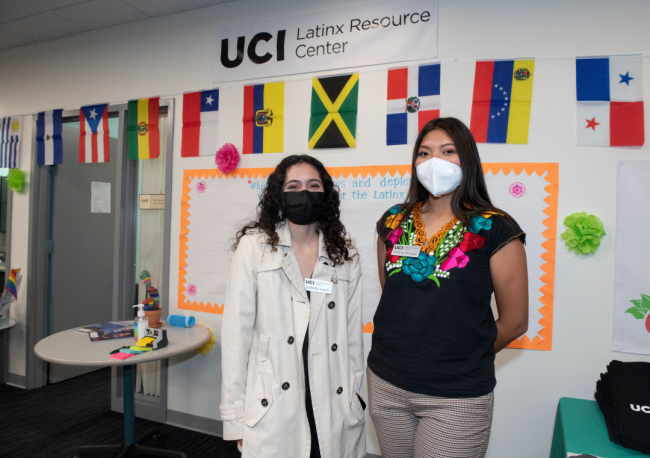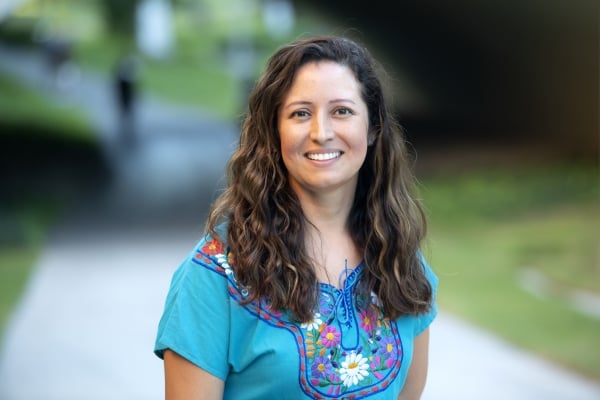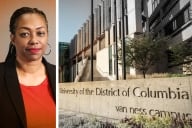You have /5 articles left.
Sign up for a free account or log in.

The University of California, Irvine, opened its Latinx Resource Center in 2019 and started delivering in-person services after students returned to campus following closures due to the COVID-19 pandemic.
UC Irvine
For the higher education practitioner on the go, engaging with Inside Higher Ed’s student success content is now more accessible than ever with the Voices of Student Success podcast.
The podcast, a companion to the Student Success news hub and subsection of The Key, Inside Higher Ed’s news and analysis podcast, will discuss solutions and innovations in higher education designed to promote persistence, engagement and graduation among today’s learners. Listeners will learn from a variety of leaders at institutions of different sizes and locations about how they’re working to improve their students’ lives in college and beyond.

Adelí Durón, inaugural director of the Latinx Resource Center at the University of California, Irvine
UCI
This week’s episode features Adelí Durón, the inaugural director of the Latinx Resource Center at the University of California, Irvine, on the center’s mission and how she works to ensure student voices inform programming, engagement and center leadership.
An edited version of the conversation follows.
Inside Higher Ed: What is your role at UCI and what does that encompass?
Durón: Our center focuses on empowering the Chicanx and Latinx community, raising awareness for social, political, economic, historical and cultural realities of Chicanx and Latinx communities in order to broaden our access and increase retention and really ensure that clear path to graduation.
We do just an array of programming workshops, really focusing on … intersectional identities. That’s really what we’ve been focused on in these beginning years. We’re a new center on the campus; we started in 2019 but didn’t physically open due to the pandemic until fall of 2021, but had been doing virtual work throughout the pandemic. We’ve been focusing on our Indigenous communities, on the intersectionality of our queer communities, of our Afro-Latinos. And so really just trying to bring students out and have them recognize that we’re here. And I know that not every student even knows that we’re here yet. We are a campus of over 30,000. So it’s hard for every single student to even become aware of every resource available on campus.
Inside Higher Ed: You mentioned intersectionality, and I know that it’s so huge in diversity and inclusion work, that students are not a monolith, they do not belong to only one group. Can you talk a little bit about what it means to find those intersectionalities within the Latinx community and how you honor and appreciate students’ identities?
Durón: It’s hard, because even the title of our center is the Latinx Resource Center, which is a monolith. It’s a word that our students chose, and so that’s why that’s the name of the center. But I know with our older communities, or alums, they don’t identify with that word [Latinx], right? It’s the word of this generation, and even the words are changing. Right now, what we’re really seeing is, is people using “Chicane” and “Latine,” that’s more in line linguistically with the Spanish language.
So what we’re really doing in terms of the intersectionality is we’re having programs—like next quarter, we’re going to be having a program on the language, like Indigenous languages, and so bringing out Indigenous students—and it is a small population, it’s not a large population. But it’s an opportunity for students to feel seen and heard. It’ll be kind of a language exchange of the Indigenous languages coming from mostly Mexico right now. But so that’s one way that we’re doing it. We have a program called Q Rants. And so that’s for our queer students. And it’s really just an open discussion; every session our intern is leading a topic and really being able to just create community with the students and have an open identifying presence.
Inside Higher Ed: You mentioned the name of the center and how students chose that. How do you see students lead in the Latinx Resource Center? And where do you see their role in giving these resources to their peers?
Durón: Really, the start of the center came from student advocacy. We’re actually located on the campus in a suite called RISE, and it stands for “rooted in student empowerment,” and … each of these centers are here are because of student advocacy.
Students advocated, they did a petition, they met with administrators—ultimately, that led to a class that was— There was normally a kind of a Latino leadership seminar that was run every winter quarter at that time, and then through that class, they basically changed the syllabus in the curriculum to talk about what would a center look like on this campus. So other students did research that were outside of the student committee. And then that’s really where, between this class and a student committee or a proposal for the center— It was always with the idea that we were going to honor the work that students had been doing on this campus students have led many of our campuswide programming.
For over 30 years, we’ve had Nuestra Graduación, which is formerly known as Raza Grad, and we’ve had La Bienvenida, which is a welcome event, and then a newer program that started maybe about five to seven years ago called La Despedida, which is kind of the goodbye event.
These are the three, I would say, signature programs that have been student-run for many years. As part of the transition to the LRC, the students essentially— At the time, there was an organization that was kind of serving as the umbrella … to host some of those programs. And so the students essentially gave me La Bienvenida to continue the legacy and the affiliates program.
We have a program called Mesa Unida, which is the student leaders of all the Chicanx and Latinx student organizations. It’s through their work that we’re able to really do what we want to do and really see their vision through within our center specifically.
We also have a group of interns: we have a wellness intern, a QTBIPOC intern, Indigenous programs intern, community programs intern. With their internship positions, there’s things that they’re responsible for, but there’s also room for creativity. We kind of have them come up with ideas on how they want the programming to look that year, what topics they want to cover, and then we help guide them—maybe we know a speaker based on something they want to do, or they do research on speakers. And so together, we work to make their vision of that program that workshop a reality.
Inside Higher Ed: When it comes to student success, we see graduation [and] persistence as some of those large metrics. But where does cultural competency lie in those services? And where do you see a need for culturally responsive services for students?
Durón: So we’re a Hispanic-serving institution. Our undergraduate population is at 26.2 percent Hispanic and our graduate students [are] at 14.4 percent [Hispanic].
Twenty years ago, when I was a student—because I was a student here as well—it was like 12 percent. So for me, this number just seems exponentially larger, and students should, in my opinion, should feel that community, should see themselves. But the reality is the demographics of California have changed so much that many of our students, because we have a high first-generation population as well, they’re coming from communities where 80 percent or 90 percent of their peers in their high schools or in their middle schools were of the Chicano, Latino, Hispanic population. That is who they saw every day.
So when they’re coming to this campus, they’re still seeing a culture shock, even though I’m like, “But it’s 25 percent—don’t you see more?” And they don’t, they don’t because they’re comparing it to what they saw in high school. I think that it’s really important for them to see that community, to see that the campus is doing work. Even if they’re not always coming, you know, sometimes we hear that, like, “I see your emails, I see what you’re doing is great. Sorry, I haven’t come to anything.” I think just the feeling of knowing that the campus is doing something is important for feeling integrated into the campus.
For students to really feel part of their community, I think, they have to learn about themselves. Yes, we have the major, we have Chicano/Latino studies as a major interest, and we obviously encourage students to do the major if that’s where they want to do their academics. And likewise, the department encourages them to attend our programs and sends them information about our program. So I think there’s opportunities for students to learn different things from each of the communities.
And then the other thing is that we’re also trying to do work that is also intersectional of our ethnic identities, right? So that it’s not very Mexican American–centric. We try and bring speakers from different ethnicities as well. And I think that adds to that competency of our students and really getting a breadth of what that means for them.
Inside Higher Ed: Something else I wanted to talk about is the Latinx-focused resources—you have a Latinx resource database. Can you talk about what that is and where that came from?
Durón: We have this wonderful collaboration called the UCI-OC Alliance for Latinx Thriving University. There are 30 to 40 business leaders in the Orange County community who want to help and serve students in different ways and really find what is the campus not doing. How can we help improve the campus? Or how can we serve as mentors and guide more students to make sure that they’re graduating and that they’re getting to their careers?
One of the things that bore fruit out of that alliance was this Latinx Resource Guide. With the help of staff and the alliance members really putting together, we had an old list that was a printed list, but ever since that … so much has happened on this campus.
We have over 140 resources listed on this website; all of those resources, in order to be on this list, have to be serving 50 percent or more Latinos. So what that means is that it’s not just resources serving our students, it’s resources serving the community as well [including] our K-12 outreach, actually, really, our K-14 outreach, because we’re serving the community college system as well.
What we’re doing, really, it’s just a simple database that leads people to the main website for that organization, but it puts all of the resources that we’re offering in one space. A lot of these programs aren’t necessarily, when you think, “Oh, they’re serving 50 percent or more Latinos, it’s because ‘Latino’ or ‘Hispanic’ or ‘Chicanos’ in the title.” No, it’s not because of that. It just happens that whatever that program is, that’s mainly meant to serve first-generation or underrepresented students, then our student population or Hispanic [population] is gravitating toward these programs.
Inside Higher Ed: How have you seen students respond or use that resource? Or what metrics do you look at to see how well that’s working for them?
Durón: It launched last year, and so I think one of the things that we’re really looking at is increasing the marketing of the resource guidance. I’m really hoping this will help. Because the other part of it is, it’s not just for students to see it, but also for community members to see it.
So if we have folks in Santa Ana, which is a neighboring city, and Anaheim, what are things that they could be doing to find resources on the campus? We’re really hoping to reach kind of the larger population—what resources, what research initiatives are happening also in the community? And how can they get involved or get access to those resources?
In terms of the metrics, I think, right now, whenever we do like outreach events—so when we go to large festivals in the community, or we have our fairs here on campus—that’s when we see the spikes in people accessing the database and using it. The beauty of the database also is if they are a UCI-affiliated person, it registers their NetID, and so they can save favorites. So then that way, they don’t have to keep looking, they can go back to the database and look at their favorites. If someone in the community is using it, if they’re on the same browser, same thing, they can still save favorites, and it’ll save you time because they’re all in the same browser.
Inside Higher Ed: That’s awesome. It seems like it would be a really great guide, whenever you need it, 24-7, just able to access and find exactly what you need for a community that looks like you. You’ve mentioned a lot of great programs and initiatives at UCI. Is there anything that you’re looking forward to or something that my listeners should keep a lookout for?
Durón: We have a big program called the Latino Excellence Achievement Dinner. It’s one of a kind in the UC system, and it’s actually geared toward graduate students. So that’s another kind of niche population that many student affairs offices aren’t— It’s always seen as an undergraduate resource, right? But our goal is to also be serving the graduate students.
So this also came from a graduate student at the time, for advocacy of realizing that the graduate student numbers [are lacking]. Our campus is Hispanic serving, we’re 25 percent [Hispanic/Latino] at the undergraduate level, but at that time, we were, like, 9 percent [Hispanic/Latino] at the graduate level. So really wanting to say, “Where are the students?” Everyone’s in small cohorts. “How do we find them?”
And so what this did is it allowed for the university to recognize graduate students within their school. Every school nominates one graduate student to receive an award that year, and it’s for graduate student excellence, sometimes focused specifically on research—if it’s the M.B.A.s, focused on leadership. Each student receives an award. We invite undergraduates to also attend the dinner and see where students are leading; we market it on social media, so you’ll see it on our Instagram. This event happens in April every year, on the first week of April. What we were able to do the third year of the program is add a stipend fellowship. So each graduate student receives a $1,000 fellowship stipend.
Staff became heavily involved, because this was kind of like a committee, they came together to support the student and her vision of what she wanted to do. We also have a couple of staff and alumni and community-builder awards, because we didn’t have another formal celebration. But the focus is on the graduate students and their excellence. We believe that this program has allowed for the schools to see where their diversity lives within the community. If we look at 2016, if it was 9 percent, and now we’re at 14 percent, that’s a very small window to have gone up that many percentage points. We think that this program has really helped in increasing the enrollment of the Hispanic and Chicano, Latinx student population at the graduate level.
Get more content like this directly to your inbox every weekday morning. Subscribe here.








